Abstract
Rhinoviruses and enteroviruses are the major members of the picornavirus genus that cause human disease. We compared the polymerase chain reaction and viral culture for the identification of picornaviruses in nasal aspirates from children during episodes of respiratory symptoms and when asymptomatic and from asymptomatic adults. One hundred eight children, aged 9 to 11 years, completed a year-long study. Within 24 to 48 h of a report of respiratory symptoms, a nasal aspirate was taken in the home. Nasal aspirates were also taken from 65 of the children and from 33 normal adults when they had been free of respiratory symptoms for at least 2 weeks. Picornaviruses were isolated by culture for three passages in Ohio HeLa cells in rolling tubes at 33 degrees C and pH 7.0. For the polymerase chain reaction, duplicate 50-microliters samples were amplified with conserved primers from the 5' noncoding region. Picornaviruses generated approximately 380-bp bands in agarose gel electrophoresis; the specificity of these bands was confirmed by filter hybridization with a conserved internal probe. Picornaviruses were isolated by culture in 47 (46 rhinoviruses) of 292 symptomatic episodes (16%), whereas the polymerase chain reaction identified picornavirus genomic material in 146 episodes (50%), including all but one of the culture-positive episodes. As for asymptomatic samples, eight (12%) children and two (4%) adults were positive by the polymerase chain reaction, whereas only one child's specimen was positive by culture. This polymerase chain reaction assay represents a clear advance in the identification of picornavirus infection, with a detection rate threefold greater than the virus culture method.
Full text
PDF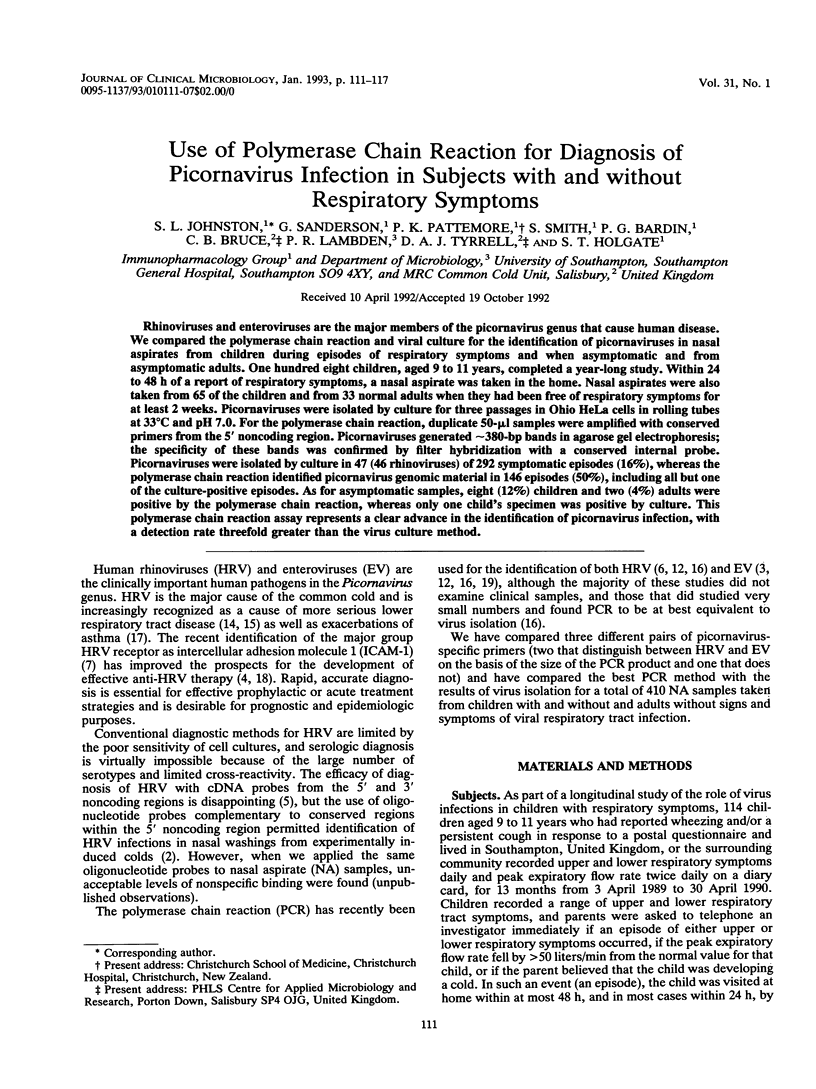
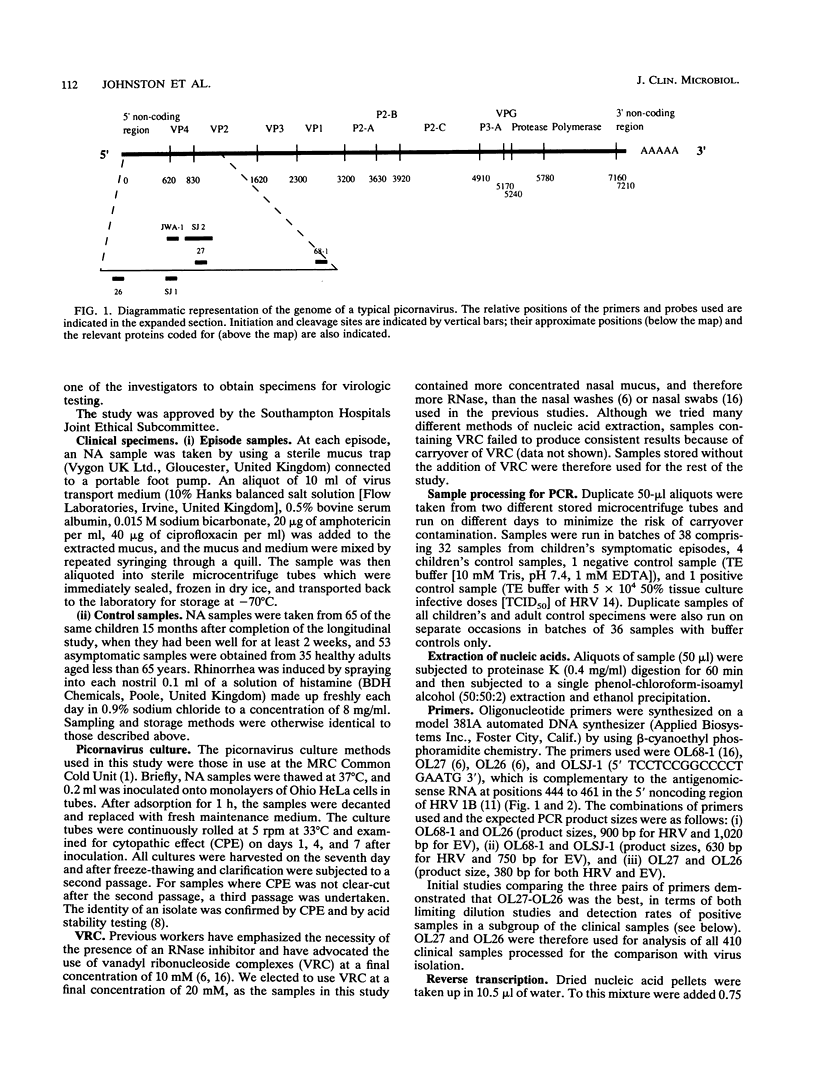

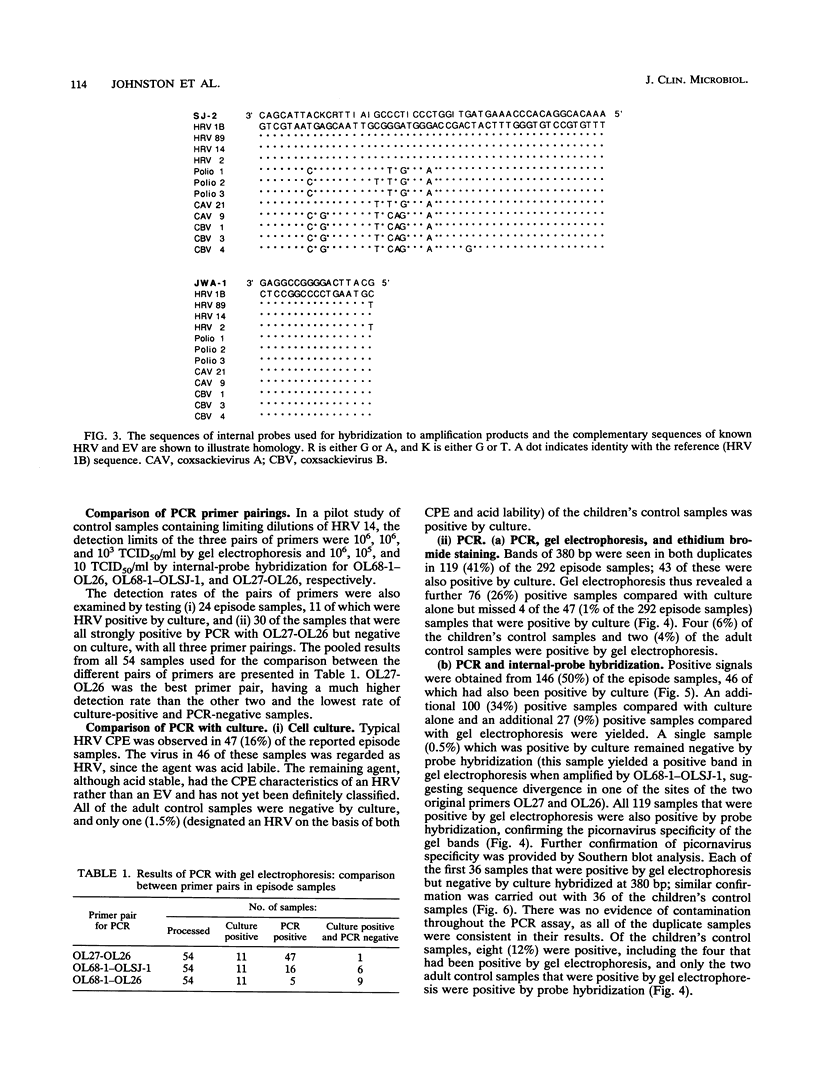
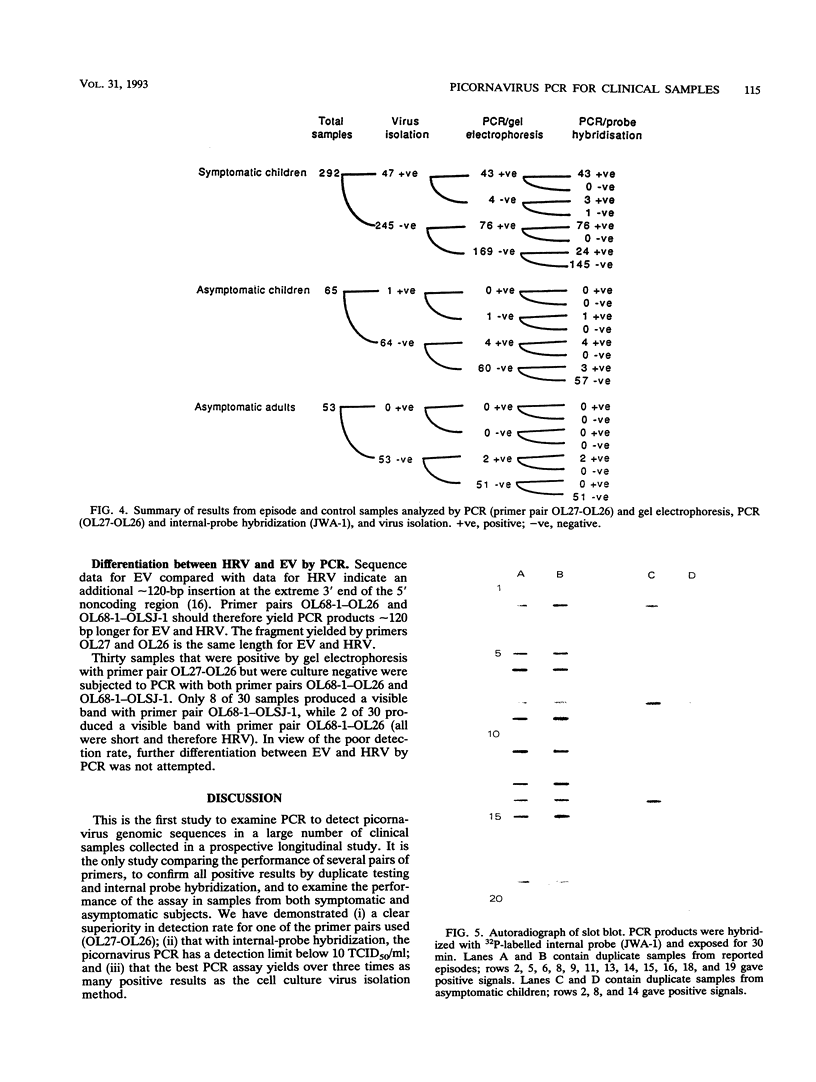

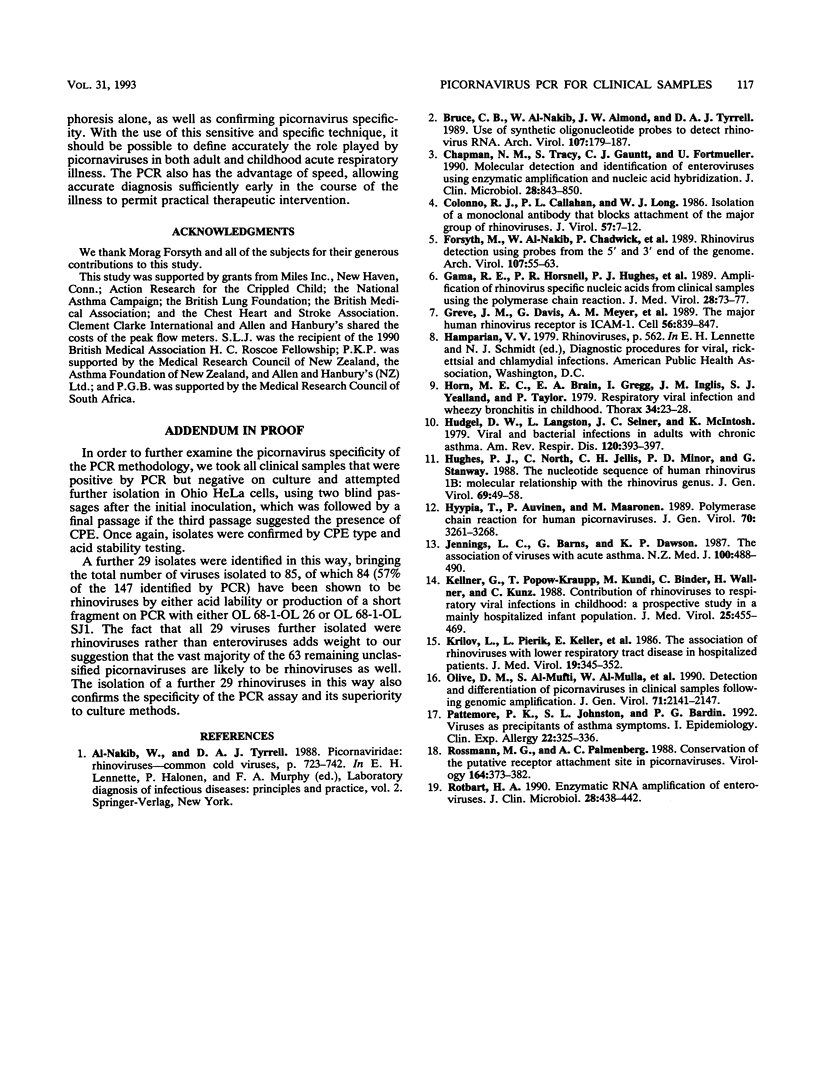
Images in this article
Selected References
These references are in PubMed. This may not be the complete list of references from this article.
- Bruce C. B., al-Nakib W., Almond J. W., Tyrrell D. A. Use of synthetic oligonucleotide probes to detect rhinovirus RNA. Arch Virol. 1989;105(3-4):179–187. doi: 10.1007/BF01311355. [DOI] [PMC free article] [PubMed] [Google Scholar]
- Chapman N. M., Tracy S., Gauntt C. J., Fortmueller U. Molecular detection and identification of enteroviruses using enzymatic amplification and nucleic acid hybridization. J Clin Microbiol. 1990 May;28(5):843–850. doi: 10.1128/jcm.28.5.843-850.1990. [DOI] [PMC free article] [PubMed] [Google Scholar]
- Colonno R. J., Callahan P. L., Long W. J. Isolation of a monoclonal antibody that blocks attachment of the major group of human rhinoviruses. J Virol. 1986 Jan;57(1):7–12. doi: 10.1128/jvi.57.1.7-12.1986. [DOI] [PMC free article] [PubMed] [Google Scholar]
- Forsyth M., al-Nakib W., Chadwick P., Stanway G., Hughes P. J., Leckie G., Almond J. W., Tyrrell D. A. Rhinovirus detection using probes from the 5' and 3' end of the genome. Arch Virol. 1989;107(1-2):55–63. doi: 10.1007/BF01313878. [DOI] [PMC free article] [PubMed] [Google Scholar]
- Gama R. E., Horsnell P. R., Hughes P. J., North C., Bruce C. B., al-Nakib W., Stanway G. Amplification of rhinovirus specific nucleic acids from clinical samples using the polymerase chain reaction. J Med Virol. 1989 Jun;28(2):73–77. doi: 10.1002/jmv.1890280204. [DOI] [PubMed] [Google Scholar]
- Greve J. M., Davis G., Meyer A. M., Forte C. P., Yost S. C., Marlor C. W., Kamarck M. E., McClelland A. The major human rhinovirus receptor is ICAM-1. Cell. 1989 Mar 10;56(5):839–847. doi: 10.1016/0092-8674(89)90688-0. [DOI] [PubMed] [Google Scholar]
- Horn M. E., Brain E. A., Gregg I., Inglis J. M., Yealland S. J., Taylor P. Respiratory viral infection and wheezy bronchitis in childhood. Thorax. 1979 Feb;34(1):23–28. doi: 10.1136/thx.34.1.23. [DOI] [PMC free article] [PubMed] [Google Scholar]
- Hudgel D. W., Langston L., Jr, Selner J. C., McIntosh K. Viral and bacterial infections in adults with chronic asthma. Am Rev Respir Dis. 1979 Aug;120(2):393–397. doi: 10.1164/arrd.1979.120.2.393. [DOI] [PubMed] [Google Scholar]
- Hughes P. J., North C., Jellis C. H., Minor P. D., Stanway G. The nucleotide sequence of human rhinovirus 1B: molecular relationships within the rhinovirus genus. J Gen Virol. 1988 Jan;69(Pt 1):49–58. doi: 10.1099/0022-1317-69-1-49. [DOI] [PubMed] [Google Scholar]
- Hyypiä T., Auvinen P., Maaronen M. Polymerase chain reaction for human picornaviruses. J Gen Virol. 1989 Dec;70(Pt 12):3261–3268. doi: 10.1099/0022-1317-70-12-3261. [DOI] [PubMed] [Google Scholar]
- Jennings L. C., Barns G., Dawson K. P. The association of viruses with acute asthma. N Z Med J. 1987 Aug 12;100(829):488–490. [PubMed] [Google Scholar]
- Kellner G., Popow-Kraupp T., Kundi M., Binder C., Wallner H., Kunz C. Contribution of rhinoviruses to respiratory viral infections in childhood: a prospective study in a mainly hospitalized infant population. J Med Virol. 1988 Aug;25(4):455–469. doi: 10.1002/jmv.1890250409. [DOI] [PubMed] [Google Scholar]
- Krilov L., Pierik L., Keller E., Mahan K., Watson D., Hirsch M., Hamparian V., McIntosh K. The association of rhinoviruses with lower respiratory tract disease in hospitalized patients. J Med Virol. 1986 Aug;19(4):345–352. doi: 10.1002/jmv.1890190407. [DOI] [PubMed] [Google Scholar]
- Olive D. M., Al-Mufti S., Al-Mulla W., Khan M. A., Pasca A., Stanway G., Al-Nakib W. Detection and differentiation of picornaviruses in clinical samples following genomic amplification. J Gen Virol. 1990 Sep;71(Pt 9):2141–2147. doi: 10.1099/0022-1317-71-9-2141. [DOI] [PubMed] [Google Scholar]
- Pattemore P. K., Johnston S. L., Bardin P. G. Viruses as precipitants of asthma symptoms. I. Epidemiology. Clin Exp Allergy. 1992 Mar;22(3):325–336. doi: 10.1111/j.1365-2222.1992.tb03094.x. [DOI] [PMC free article] [PubMed] [Google Scholar]
- Rossmann M. G., Palmenberg A. C. Conservation of the putative receptor attachment site in picornaviruses. Virology. 1988 Jun;164(2):373–382. doi: 10.1016/0042-6822(88)90550-8. [DOI] [PubMed] [Google Scholar]
- Rotbart H. A. Enzymatic RNA amplification of the enteroviruses. J Clin Microbiol. 1990 Mar;28(3):438–442. doi: 10.1128/jcm.28.3.438-442.1990. [DOI] [PMC free article] [PubMed] [Google Scholar]




